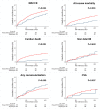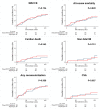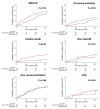Impact of P2Y12 inhibitors on cardiovascular outcomes of Korean acute myocardial infarction patients with baseline thrombocytopenia
- PMID: 36186989
- PMCID: PMC9515375
- DOI: 10.3389/fcvm.2022.921955
Impact of P2Y12 inhibitors on cardiovascular outcomes of Korean acute myocardial infarction patients with baseline thrombocytopenia
Abstract
Background: Antiplatelet therapy is crucial for managing acute myocardial infarction (AMI) and reducing adverse ischemic events after percutaneous coronary intervention (PCI) with drug-eluting stents. However, the ideal P2Y12 inhibitor for patients-particularly East Asians-with AMI and low platelet levels remains unknown. We evaluated the impact of various potencies of P2Y12 receptors on major cardiovascular outcomes of AMI patients with thrombocytopenia in Korea.
Methods: We analyzed the clinical and outcome data of 800 AMI patients with baseline platelet counts <150 × 103/μL who underwent PCI between November 2011 and June 2015. All patient data were obtained from the Korea Acute Myocardial Infarction Registry-National Institutes of Health registry. Subjects were allocated to group A (n = 244; treated with potent P2Y12 inhibitors) or group B (n = 556; treated with clopidogrel). The primary endpoint was major adverse cardiac and cerebrovascular events (MACCEs).
Results: At the 3-year follow-up, clinical outcomes appeared better in group A than in Group B. However, after propensity score weighting-adjusted analysis, these findings were statistically attenuated, showing a similar incidence of MACCEs between the two groups.
Conclusions: Clopidogrel may be reasonable for patients with low platelet counts and is associated with comparable outcomes to potent P2Y12 inhibitors for Korean AMI patients.
Keywords: Republic of Korea; antiplatelet drugs; myocardial infarction; percutaneous coronary intervention; thrombocytopenia.
Copyright © 2022 Oh, Jeong, Cho, Kim, Sim, Hong, Kim and Ahn.
Conflict of interest statement
The authors declare that the research was conducted in the absence of any commercial or financial relationships that could be construed as a potential conflict of interest.
Figures




Similar articles
-
Association of potent P2Y12 blockers with ischemic and bleeding outcomes in non-ST-segment elevation myocardial infarction.J Cardiol. 2019 Feb;73(2):142-150. doi: 10.1016/j.jjcc.2018.09.002. Epub 2018 Oct 26. J Cardiol. 2019. PMID: 30509351
-
Third-Generation P2Y12 Inhibitors in East Asian Acute Myocardial Infarction Patients: A Nationwide Prospective Multicentre Study.Thromb Haemost. 2018 Mar;118(3):591-600. doi: 10.1055/s-0038-1626697. Epub 2018 Mar 13. Thromb Haemost. 2018. PMID: 29534250
-
Ticagrelor versus clopidogrel in acute myocardial infarction patients with multivessel disease; From Korea Acute Myocardial Infarction Registry-National Institute of Health.J Cardiol. 2020 May;75(5):478-484. doi: 10.1016/j.jjcc.2019.11.003. Epub 2019 Dec 16. J Cardiol. 2020. PMID: 31859138
-
New horizons of acute myocardial infarction: from the Korea Acute Myocardial Infarction Registry.J Korean Med Sci. 2013 Feb;28(2):173-80. doi: 10.3346/jkms.2013.28.2.173. Epub 2013 Jan 29. J Korean Med Sci. 2013. PMID: 23399991 Free PMC article. Review.
-
Efficacy and safety analysis of new P2Y12 inhibitors versus clopidogrel in patients with percutaneous coronary intervention: a meta-analysis.Curr Med Res Opin. 2015 Dec;31(12):2313-23. doi: 10.1185/03007995.2015.1098600. Epub 2015 Nov 4. Curr Med Res Opin. 2015. PMID: 26402735 Review.
References
-
- Ibanez B, James S, Agewell S, Antunes MJ, Bucciarelli-Ducci C, Bueno H et al. 2017 ESC Guidelines for the management of acute myocardial infarction in patients presenting with ST-segment elevation: the task force for the management of acute myocardial infarction in patients presenting with ST-segment elevation of the European Society of Cardiology (ESC). Eur Heart J. (2018) 39:119–77. 10.1093/eurheart/ehx393 - DOI - PubMed
-
- Zijlstra F, Patel A, Jones M, Grines CL, Ellis S, Garcia E et al. Clinical characteristics and outcome of patients with early (<2 h), intermediate (2-4 h) and late (>4 h) presentation treated by primary coronary angioplasty or thrombolytic therapy for acute myocardial infarction. Eur Heart J. (2002) 23:550–7. 10.1053/euhj.2001.2901 - DOI - PubMed
LinkOut - more resources
Full Text Sources
Miscellaneous

